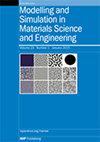多元素共偏析对mg101 - 2孪晶界力学性能的协同效应
IF 2.4
4区 材料科学
Q3 MATERIALS SCIENCE, MULTIDISCIPLINARY
Modelling and Simulation in Materials Science and Engineering
Pub Date : 2023-06-22
DOI:10.1088/1361-651X/ace0d2
引用次数: 1
摘要
晶界的性质明显受到外来元素偏析的影响。用第一性原理计算系统地研究了共偏析行为对mg101 - 2孪晶GB力学性能的协同效应。选择了Ni、Mn、Zn、Al、Ag、Ti、Li、Zr、Y、Ca等10种元素进行单组分偏析,选择了Al - Ca、Al - Y、Zn - Ca、Zn - Y等4种溶质组合进行共组分偏析,计算了不同元素浓度下的偏析能和溶解度能,评价了相应偏析产物的热力学稳定性。这些溶质原子对体系的稳定性有独特的作用,溶质原子之间的相互作用对体系的稳定性也有协同作用。结果表明,无论是单元素偏析还是共元素偏析,随着适当位置溶质原子浓度的增加,偏析倾向增强,GB结构趋于稳定。共偏析导致的电荷重分布显著地影响了石墨烯的结合和力学性能。随着共偏析浓度的增加,层状电荷在基体和孪晶之间转移,电子杂化进一步增强,界面结合显著增强。这表明溶质元素的适当组合可以有效地改善界面的力学性能。揭示了元素偏析对镁合金力学性能影响的理论认识,为镁合金工程中力学性能的调整提供了设计思路。本文章由计算机程序翻译,如有差异,请以英文原文为准。
Synergistic effect of multi-element co-segregation on mechanical properties of Mg 101ˉ2 twin grain boundary
Properties of grain boundaries (GBs) are pronouncedly influenced by alien elemental segregation. Synergistic effect of co-segregation behavior on mechanical properties of Mg 101ˉ2 twin GB was systematically investigated with first-principles calculations. Ten elements (Ni, Mn, Zn, Al, Ag, Ti, Li, Zr, Y, Ca) for single segregation and four solute combinations (Al–Ca, Al–Y, Zn–Ca, Zn–Y) for co-segregation were chosen respectively, the segregation energies and solubility energies with different elemental concentrations were calculated to evaluate the thermodynamic stability of corresponding segregated GBs. These solute atoms have unique effects on the stability of the system, and the interaction between solute atoms also has a synergistic effect on the stability of the system. It is found that the segregation tendency is enhanced and the GB structure tends to be stable with the increase of the concentration of solute atoms at the appropriate sites, regardless of single-element segregation or co-segregation. The redistribution of GB charges due to co-segregation significantly affects the binding and mechanical properties of GBs. With the increase of the co-segregation concentration, the lamellar charge is transferred between the matrix and the twins, which further enhances the electron hybridization and leads to a notable enhancement of interface binding. This shows that the appropriate combination of solute elements can effectively improve the mechanical properties of the interface. The manuscript reveals the theoretical understanding of the effect of elemental segregation on the mechanical properties of GB, and provides design ideas for the tuning of mechanical properties of magnesium alloy by GB engineering.
求助全文
通过发布文献求助,成功后即可免费获取论文全文。
去求助
来源期刊
CiteScore
3.30
自引率
5.60%
发文量
96
审稿时长
1.7 months
期刊介绍:
Serving the multidisciplinary materials community, the journal aims to publish new research work that advances the understanding and prediction of material behaviour at scales from atomistic to macroscopic through modelling and simulation.
Subject coverage:
Modelling and/or simulation across materials science that emphasizes fundamental materials issues advancing the understanding and prediction of material behaviour. Interdisciplinary research that tackles challenging and complex materials problems where the governing phenomena may span different scales of materials behaviour, with an emphasis on the development of quantitative approaches to explain and predict experimental observations. Material processing that advances the fundamental materials science and engineering underpinning the connection between processing and properties. Covering all classes of materials, and mechanical, microstructural, electronic, chemical, biological, and optical properties.

 求助内容:
求助内容: 应助结果提醒方式:
应助结果提醒方式:


